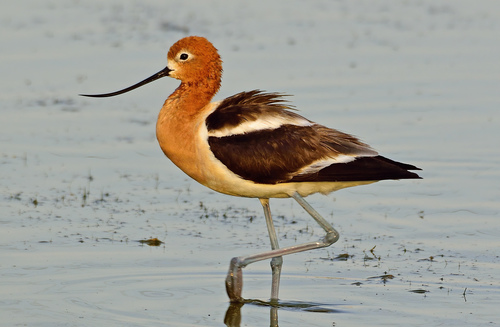
American Avocet
The American Avocet (*Recurvirostra americana*) is a striking shorebird known for its elegant appearance and unique foraging behavior. It plays a vital role in wetland ecosystems, primarily consuming aquatic invertebrates and helping to regulate their populations. This species is easily recognized by its long, upturned bill, used for sweeping through shallow water to capture prey. While not holding significant cultural importance in many areas, it's a favorite among birdwatchers due to its beauty and distinctive characteristics. It is a symbol of the health and vitality of wetland habitats across North America.
40-51 cm
Length
68-76 cm
Wingspan
Least Concern
Conservation Status
Distribution
The American Avocet breeds primarily in western and central North America, from southern Canada to the southern United States. During the non-breeding season, they migrate south to the southern US, Mexico, and Central America, with some reaching as far as Guatemala. Their migratory routes often follow coastlines and major river systems.
Lifespan
The average lifespan in the wild is estimated to be 9-15 years, although some individuals may live longer.
American Avocet's Habitat
Habitat Types
Shallow freshwater wetlands, Brackish marshes, Salt ponds, Mudflats, Shorelines of lakes and reservoirs
Climate Zones
Temperate, Subtropical, Arid
Adaptations
Their long legs and partially webbed feet allow them to wade in shallow water, while their specialized bill is perfectly adapted for sweeping through water and mud to capture prey. They can tolerate a range of salinity levels in their wetland habitats.
Variations
No officially recognized subspecies exist, though minor variations in size and plumage may occur across their range. These differences are not substantial enough to warrant separate subspecies classifications.
Appearance
Breeding Plumage
Breeding plumage features a rusty-cinnamon head and neck, while non-breeding plumage is characterized by a grayish-white head and neck.
Seasonal Feather Changes
The transition between breeding and non-breeding plumage occurs through molting in late summer and early spring.
Sex Based Plumage Differences
While both sexes share similar plumage patterns, females tend to have slightly duller coloration, particularly during the breeding season.
Notable Features
Long, slender, upturned bill, Long, bluish-gray legs, Black and white striped wing pattern, Partially webbed feet
Diet and Feeding
Primary Foods
Aquatic invertebrates, Crustaceans (e.g., brine shrimp), Insects (e.g., water boatmen, midges), Small fish, Seeds of aquatic plants
Foraging Behavior
American Avocets use a distinctive scything motion with their bills, sweeping them back and forth through shallow water or mud to capture prey. They also peck at the surface or probe in the mud.
Specializations
Their upturned bill is uniquely adapted for their scything feeding technique, allowing them to efficiently filter small prey from the water.
Seasonal Diet Variations
Diet composition may vary slightly depending on prey availability, with a greater reliance on seeds during the non-breeding season when invertebrate populations may be lower.
Behavior
Social Structure
American Avocets are often found in small flocks during the breeding season and larger flocks during migration and winter. They are generally social birds.
Communication
Loud, repeated 'kleet' calls, Visual displays, including wing-lifting and head-bobbing, Alarm calls to warn of predators
Migration
American Avocets are migratory, with most populations traveling long distances between breeding and wintering grounds. They often migrate in flocks, following established routes.
Territorial or Group Behaviors
During the breeding season, they defend nesting territories against intruders. Outside of breeding, they are generally more tolerant of other individuals and may form large foraging and roosting flocks.
Conservation
Threats
Habitat loss and degradation (wetland drainage), Pollution (pesticides, heavy metals), Climate change (altered precipitation patterns, sea-level rise), Human disturbance (recreational activities)
Protection Programs
Wetland restoration and conservation projects, Migratory Bird Treaty Act protection, State and federal wildlife refuge management
Local National Laws
Protected under the Migratory Bird Treaty Act in the United States, Canada, and Mexico.
Population Trend
Stable
Population Estimates
The global population is estimated to be around 450,000 individuals.
Interesting Facts
They can swim
Although primarily wading birds, American Avocets are capable swimmers, especially when chicks are threatened by predators.
Their bill curvature develops over time
Chicks are born with straight bills, and the upward curve develops as they mature.
Highly sensitive bill
Their bill contains specialized sensory receptors that help them detect prey in murky water or mud.
Faqs about American Avocet
What is the purpose of the American Avocet's upturned bill?
The upturned bill is used for a specialized feeding technique called scything, where the bird sweeps its bill back and forth through shallow water to capture small invertebrates.
Are American Avocets endangered?
No, the American Avocet is currently classified as Least Concern by the IUCN, meaning it is not currently facing a high risk of extinction.
Where can I see American Avocets?
American Avocets can be found in shallow wetlands, marshes, and along shorelines throughout western and central North America during the breeding season, and along the coasts of the southern US, Mexico, and Central America during the winter.
Copyright @ Nature Style Limited. All Rights Reserved.
 English
English